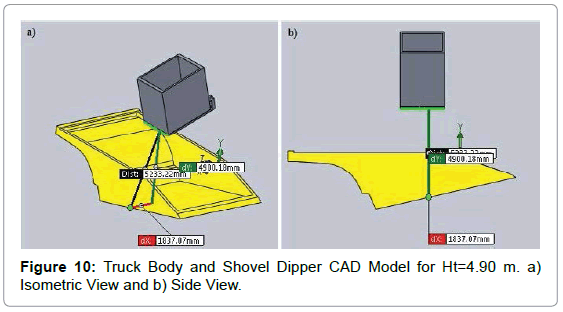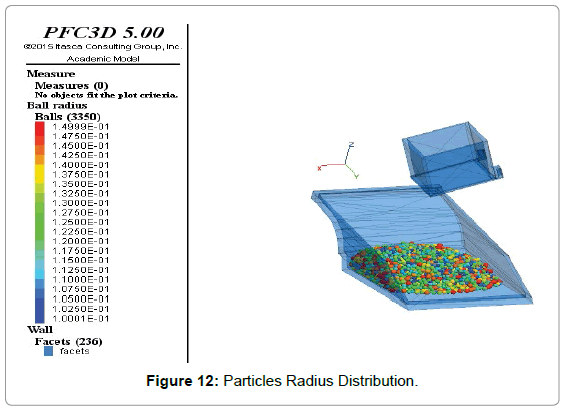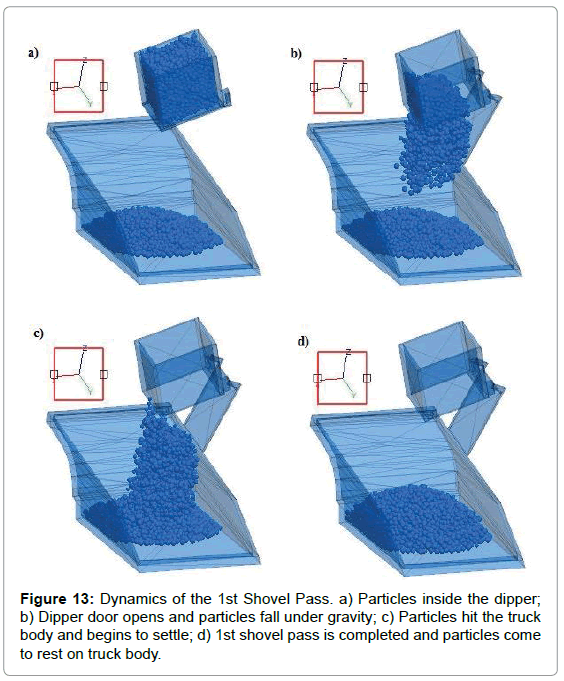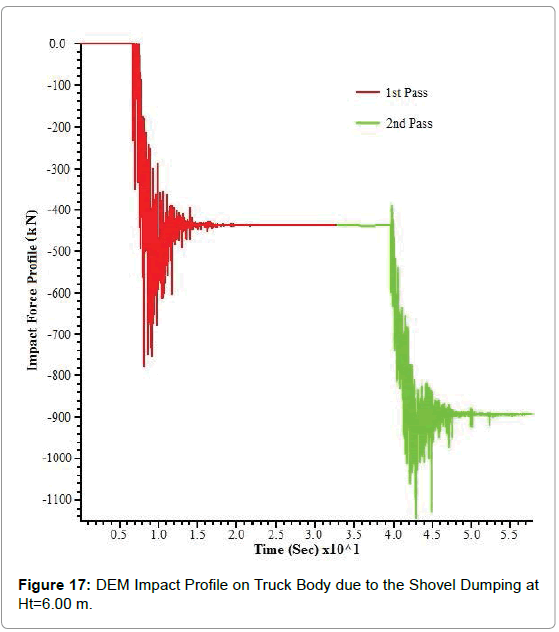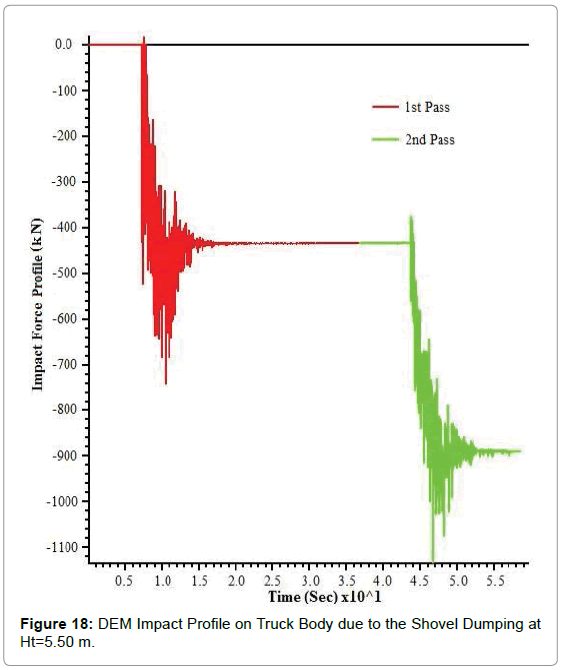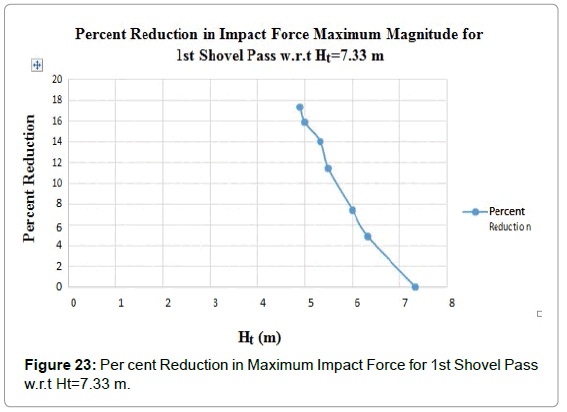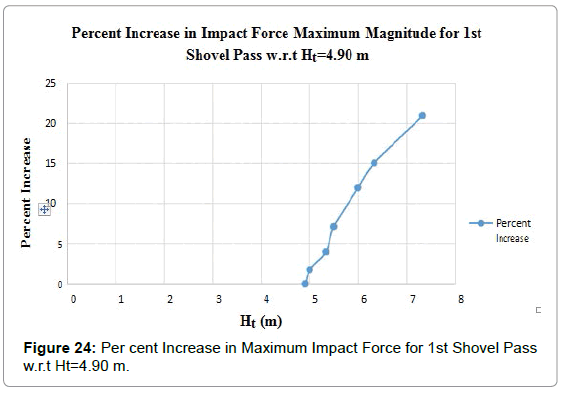Research Article Open Access
Virtual Simulation of High Impact Shovel Loading Operation for Optimum Dumping Characterization
Ali D and Frimpong S*
Department of Mining and Nuclear Engineering, Missouri S&T, Rolla MO, USA
- *Corresponding Author:
- Frimpong S
Department of Mining and Nuclear Engineering
Missouri S&T, Rolla MO, USA
Tel: (573) 341-7617
E-mail: frimpong@mst.edu
Received Date: November 21, 2016; Accepted Date: January 07, 2017; Published Date: January 14, 2017
Citation: Ali D, Frimpong S (2017) Virtual Simulation of High Impact Shovel Loading Operation for Optimum Dumping Characterization. J Powder Metall Min 6: 149. doi:10.4172/2168-9806.1000149
Copyright: © 2017 Ali D, et al. This is an open-access article distributed under the terms of the Creative Commons Attribution License, which permits unrestricted use, distribution, and reproduction in any medium, provided the original author and source are credited.
Visit for more related articles at Journal of Powder Metallurgy & Mining
Abstract
The use of large machinery in surface mining operations has resulted in high-impact shovel loading operations (HISLO). When large capacity shovels dump 100+ tons of loads in a single pass, large impact forces are generated resulting in high frequency shock waves. These shock waves cause severe truck vibrations, and thus, expose dump truck operators to high levels of whole body vibrations (WBV) and impact the health and safety of operators. The operator’s lower torso, lower back, legs, feet and hands are exposed to these WBV levels, which ultimately result in lower back injuries, musculoskeletal diseases and other long-term injuries. There exists no fundamental work to address this problem except a rigorous mathematical model for this impact force developed by previous researchers. This paper outlines a pioneering effort to develop a 3D virtual simulation model for a shovel dumping operation using DEM techniques in PFC3D. The model captures material dumping from a P&H 4100XPC shovel into a CAT 793D truck. Analysis of the simulation results showed that a per cent reduction of 4.88, 7.42, 11.45, 12.01, 15.08 and 17.34% can be achieved by reducing the dumping height from 7.33 m to 6.33, 6.00, 5.50, 5.33, 5.00 and 4.9 m, respectively. As a result of the cushioning effect, the reduction in the impact force magnitude ranges between 8.2% and 10.5%. This simulation model can be used to analyse any HISLO operation to reduce or possibly eliminate WBV exposures by optimizing the shovel dumping height to reduce the impact force.
Keywords
Impact force; HISLO; PFC3D; Dumping height; DEM; Virtual simulation; Whole body vibrations
Introduction
Shovel truck system has become a more flexible, economic and productive method for surface mining operations over the years as a result of advancement in technologies. Studies have shown, for example, that one can observe a four times increase in productivity for a 380-ton dump truck, as compared with the productivity of a 120- ton truck. Thus, one can easily achieve higher economic advantages by matching the larger shovels with larger trucks/dumpers. As large capacity shovels load large capacity dumpers with over 100+ tons in single passes under gravity, they generate high frequency shock waves and create large impact forces on the dumper machinery. The use of large scale shovels and dump trucks has resulted in high impact shovel loading operations (HISLO) in surface mining. The shockwaves generated, under HISLO conditions, propagate through the truck body, chassis and to the operator’s cabin and the seat, thus exposing the operators’ feet, legs, lower back, hands, spine and neck to these high frequency shockwaves. This experience and exposure are termed as whole body vibration (WBV). Even though a lot is known about the type of vibration generated in mining trucks as a result of the research carried out by Aouad and Frimpong (2013), there is a lack of expertise and understanding about how to control the vibrations generated within dump trucks in surface mining operations [1-3]. The HISLO vibrations are forced vibrations induced by the generated force from material impact. The available literature has allowed the authors to evaluate the contributions by researchers to the body of knowledge on impact force modelling. Studies from Iverson (2003) and Metz (2007) have focused on determining the impact force of a single body through impact test or using software packages (e.g. PFC3D) [4,5]. However, none of these studies focused on determining the impact force generated by flowing material under gravity. Impact forces from Aouad and Frimpong (2013) are a bit overestimated because the material was considered to have been dumped at once. In reality, the material is generally well fragmented either during the direct shovel excavation or due to blasting prior to shovel digging for some hard rock materials. In any of these cases, the material dumped into the truck would consist of large amount of small size particles. Thus, there will be a continuous material flow from the shovel dipper. Therefore, the dynamic impact force curve will be continuous over the period of shovel dumping process. The shovel swings back, digs and dumps another 100 tons of Material to execute the second pass after the first pass. The resulting impact force is reduced compared to the first pass because of the damping provided by the material from the first pass via a phenomenon known as “cushioning effect”. The resulting vibration of the truck body, chassis and the operator cabin will be reduced accordingly (Figure 1).
This reduction in vibrations also reduces WBV levels within the human body. The cushioning effect has not been studied before. The dynamic impact force for the second pass has also been assumed to have a similar magnitude as that of first pass or only the first pass is considered during the vibration analysis for operator health risk evaluations [6]. Therefore, in order to determine a more realistic dynamic impact force under the HISLO conditions, a 3D virtual simulation of the shovel dumping process, using discrete element modelling (DEM) technique is used to model and simulate the process in this paper. The virtual DEM simulator allows the evaluation of the cushioning effect in subsequent passes after the first pass. The cushioning effect and continuous material flow, which intuitively reduce the impulse force, provide a rationale for studying the effects of the impulse force in detail. The study develops a 3-D virtual simulation model of the HISLO conditions, using the DEM technique in PFC3D. The results and the findings from this work can further be used to analyse the shovel dumping process in detail for selecting optimum parameters (i.e. dumping height) to reduce the resulting impact force and minimize the shockwaves/vibrations within the dump truck.
Research Methodology
A 3-D virtual simulation model is developed to simulate the shovel dumping process in PFC3D. Solid Works is used to create the detailed 3D geometry for the model. The geometry is then exported to Rhino 5.0, which provides tools for displaying and manipulating the geometry. Rhino 5.0 is used to generate the meshes for the corresponding geometry. The Rhino 5.0 meshes are then imported into PFC3D to simulate the material dumping process. The simulation model uses the P&H 4100XPC shovel to dump 100 tons of material into the CAT 793D dump truck under gravity for the first two passes. The DEM technique analyses the behaviour and the reactive forces of the complete system based on the motion of individual particles and their interactions. The impulse force from the dumping process is monitored and recorded over the complete duration of the shovel operation. The results from Ali and Frimpong (2016) and the virtual simulation processes are compared for verification [7]. The per cent difference for the maximum dynamic impact forces ranged between 0.03% and 1.48% and is in good agreement. The simulation results were validated using the published RMS acceleration results from the model developed by Aouad and Frimpong (2013) under the same constraints and environment. The dumping height, Ht, used was 10m as was in the work by Aouad and Frimpong (2013). The resulting input force was used in the 38-DOF CAT 793D model in the MSC ADAMS virtual platform for generating the RMS acceleration values under similar conditions for the work carried out by Aouad and Frimpong .The simulation results from the virtual prototype model based on the virtual simulation model were then compared with that obtained. The analysis showed a per cent difference ranged between 0.56% and 7.02%, which show a good agreement.
CAD Geometry and Meshing
As the first step in setting up the virtual simulation, a detailed CAD geometry of the truck and shovel dipper that reflects the actual process has been created using solid Works. A detailed CAD geometry of the dumping process is created and assembled with the proper dumping height. The CAD models maintain the shape and dimensions, as well as the relative location of components with respect to each other. Using the real world data, the dumping process is created to capture the actual CAT 793D truck and P&H 4100XPC shovel dipper (Figure 2). The isometric, front and side views of the CAT 793D truck in solid Works (Figure 3). The isometric, front and side views of the P&H 4100XPC shovel dipper in solid Works. The shovel dipper in the CAD models is positioned at a proper dumping height to mimic the dumping process. Different dumping heights have been used (from 7.33 m to 4.9 m) for the dumping process. This minimum distance ensures that a good clearance between the dipper door and the truck edges to prevent jolting and to maintain the effectiveness and the efficiency of the dumping process. These different dumping heights are chosen for the case of P&H4100 XPC cable shovel and CAT 793D dump truck.
These series of dumping heights have also been used to examine the gradual reduction in impact force with varying heights. Complex geometries of the dumping process require very fine meshes, which consumes large CPU times in DEM. The simplification of the shovel dipper model prevents the problems during the meshing of the parts with corresponding ease in the DEM analysis (Figures 4 and 5). The isometric and the front views of the truck body assembly and the shovel dipper in solid Works for dumping heights of 7.33 m and 6.33 m, respectively (Figures 6 and 7).The isometric and the front views of the truck and the shovel dipper in solid Works for dumping heights of 6.00 m and 5.50 m, respectively (Figures 7 and 8). The isometric and the front views of the truck and shovel dipper in solid Works for heights of 5.33 m and 5.00 m, respectively (Figures 9 and 10). The isometric and the front views of the truck and shovel dipper in Solid Works for the minimum height of 4.9 m. The assemblies are imported into Rhino 5.0 for meshing. The truck model uses fine polygonal mesh due to the forces developed in truck body. The shovel dipper uses a simple polygonal meshing because there is no concern for any of the forces from the dipper. The mesh for shovel dipper saves a lot of computational time during DEM analysis in PFC3D. The mesh for the dump truck and the shovel dipper assemblies in Rhino 5.0 (Figure 11).
3D Virtual Simulation in PFC3D
The dipper payload is either fragmented or soft material. In either case, the dipper payload normally consists of large amount of small particles of varying sizes and shapes. The DEM technique is the best analytical technique for such cases in which the materials are considered as a large collection of small particles interacting with each other and with other surfaces. The DEM technique is used to analyse the behaviour and reactive forces of the combined system by computing and analysing the motion of individual particles. Thus, the DEM technique simulates the dipper payload to mimic reality as it allows the creation of individual particles with specific properties and with interactions with each other and with other surfaces.
The impact force, which is exerted on the truck body, is due to the gravity dumping of the dipper payload into the dump truck. Particle Flow Code (PFC) has been used successfully by researchers and companies around the world [8,9]. It has been used for problems ranging from fundamental research on soil and rock behaviour at the laboratory scale to slope stability and rock fall hazard mitigation, hydraulic fracturing, rock-tool interactions, bulk flow, mixing, conveying and compaction of aggregates and powders, and blast furnace modelling. PFC3D 5.0 is used to virtually simulate the shovel dumping process and observe record and analyse the impact force exerted on the truck body during the process [8]. The 3-D virtual simulation of the dumping process allows the correct representation of the impact force. It also provides insight into the scientific observation of the cushioning effect due to previously dumped materials in the truck body.
For virtual simulation, the truck body and shovel dipper meshes are first imported into PFC3D. The geometries of the mesh surfaces are then converted into “walls” so that material particles can interact with those walls. By reducing the dumping height, with subsequent virtual simulation, the reduction in the resulting impact force can be observed to attain an optimum dumping height. The optimum height is the height with minimum impact force and with good clearance between the dipper door and truck edges that prevent jolting. Material particles in the form of small spherical balls are then generated into the shovel dipper. The radius of the material is distributed between 0.1 and 0.15 m. PFC3D distributes the particles using a uniform size distribution. The distribution ceases, as soon as the target density and porosity are achieved within the specified volume. The positions and the radii of the particles are drawn from the uniform distributions throughout the model domain, which is P&H4100 XPC shovel bucket in this case. Overlaps may occur between the particles during the generation process but once the command is executed and particles are generated with the modal constraint, for specified porosity and density, overlaps can be reduced by rearranging the balls. It is important that once the particles have been created, sometime cushion is allowed for them to get settled inside the dipper. This will not only allow the particle overlaps to get reduced but will also make the particles lose their energies, and thus, come to rest before opening dipper door. The particles are also distributed using the Gaussian distribution (Figure 12). The complete particle radius distribution in PFC3D for the input radius range. The appropriate particles are generated into the dipper to achieve a combined weight of 100 tons (Table 1). The properties assigned to the generated particles in PFC3D. After the 100 tons of particles are generated, contacts are created to allow the particles to interact with one another and with other surfaces (‘walls’ in PFC3D). Thus, the particles can be contained inside the dipper first and then, after the dumping process, in the truck. The contacts include particle– particle, particles-dipper, particles–door and particles–truck body.
| Rock/Soil Properties/Parameters | Values |
|---|---|
| Normal Stiffness | 0.5 × 108 N/m |
| Shear Stiffness | 0.3 × 108 N/m |
| Coefficient of Friction | 0.65 |
| Damping | 0.04% |
| Porosity | 0.32-0.33 |
| Density | 2739 kg/m3 |
| Radius | 0.1-0.15 m |
Table 1: Material Properties in PFC3D.
In PFC3D, the contact can only be created between the particles or the particles with the walls using linear contact model (LCM). LCM has been mostly used for studying cases of the particles impact on any particular surface (PFC, 2004) [10]. After creating the contacts, gravity is activated and the system is allowed to run for a few seconds for the material to settle in the dipper. After settling, rotation is activated on the dipper door. As the door rotates, the equations of motion are solved for each particle and the particles drop from the dipper under gravity to produce the impact force. After the first pass is dumped and the dipper door closes, the shovel swings back after 30 seconds to load the second pass, and the process is repeated until the truck is filled within the simulation run (Figure 13a-13d). The dynamics for the first shovel pass. The point where the particles are contained within the dipper and are allowed to settle. The point where the dipper door opens and the particles are allowed to fall under gravity. The point when the particles strike the surface of the truck bottom to exert the impact force. The point where all the particles from the first pass have been dumped into the truck (Figure 14a-14d). The dynamics for the second shovel pass. The point where the particles reappear and settle in the dipper, with the particles from the first pass already in the truck. The point where the dipper door opens and the particles are allowed to fall under gravity. The point where the second pass materials strike the particles already in the truck from the first pass. The particles in the second pass are cushioned by the materials from the first pass, and thus, exert lesser impact force. The point where all the particles from the second pass are dumped over the first pass materials in the truck.
Results and Discussion
The virtual simulation results include the impact force exerted on the dump truck due to gravity dumping of the dipper payload. The dumping process is virtually visualized to better understand the different components of the operation and the evaluation of the impact force. The purpose of the simulation was:
• To capture the dynamic impact force exerted on the dump truck,
• Investigate the cushioning effect, which is achieved during the subsequent passes after the first pass, resulting in the impact force reduction,
• Visualize and analyse the impact force,
• Obtain the optimum dumping height while maintaining the minimum clearance between the dipper door and the truck edges during material dumping.
Two shovel passes were simulated in the 3D virtual simulation in PFC3D. The maximum dumping height of 7.33 m was used as the starting point in the simulation experiments, and was gradually reduced to 4.90 m. It must be noted that the maximum and the optimal dumping heights in this study apply only to the P&H 4100XPC cable shovel and the CAT 793D dump truck in this study. For any other shovel-truck combinations, these dumping heights may be different (Figure 15). The impact force on the truck due to gravity dumping of material from the dipper with a dumping height of 7.33 m. Initially, the material settles within few seconds after dumping. The material makes the first contact with the truck, in the first pass, at 7.44 seconds. The maximum impact force of 838 KN occurs at 8.72 seconds. At 12.3 seconds, the shovel completes the first pass and returns to repeat the process.
The particles completely come to rest at 20 seconds, which is almost 8 seconds after the first pass. Upon completing the first pass and the particles settle, the force on the truck still exists and remains constant until after the second pass. This constant force is the total gravitational force of the material in the truck. The impact forces recorded in the initial portion which are above this constant force are only due to the fact that the material particles bounce off a little after their first impact with the truck. This phenomenon is due to the rigid nature of the truck. The simulation model detects the force and marks the point on the curve only when the particles come in contact with the truck. When few particles lose their contact with the truck, the point marked on the curve goes above the constant gravitational force. After the first pass, the shovel swings back and loads the next 100 tons of material within 30 seconds and then swings back to complete the second pass. The second pass material makes the first contact with the truck body at 43.72 seconds. The maximum impact force in the second pass occurs at 45 seconds with a magnitude of 757 KN. The impact force from the second shovel pass is less than that of the first pass due to the cushioning effect from the material already in the truck from the first pass. At 56 seconds, the particles settle and the impact force again is constant, which now includes the total material gravitational force from the passes on the truck (Figure 16).
The impact force on the truck due to gravity dumping of material from the dipper at a dumping height of 6.33 m. Again two shovel passes are simulated and the material takes few seconds to settle in the dipper. The material makes the first contact with the truck at 8.34 seconds in the first pass. The maximum impact force of 800 KN occurs at 11.92 seconds during the first pass. The reduction in the time at which the maximum impact occurs, is due to the reduction in the dumping height. The shovel completes the first pass and returns at 13.3 seconds. After the first pass is completed and the particles settle, the total gravitational force of the material in the truck still exists and it is equal to that of the gravitational force in Figure 15 for Ht=7.33 m. The shovel swings back in 30 seconds after the first pass to load another 100 tons of material in the second pass. The second shovel pass materials make the first contact with truck at 43.3 seconds. The maximum impact force of 723 KN occurs at 45.7 seconds. Again the impact force from the second shovel pass is less than that of the first pass due to the cushioning effect. At 57 seconds, the particles settle and the impact force again is constant. This force includes the total gravitational force of the material from two passes in the truck. Comparing Figures 15 and 16, it can clearly be observed that the maximum impact forces in both shovel passes have been reduced because of a reduction in the shovel dumping height by 1 m (Figure 17).
The impact force on the truck due to gravity dumping of the material from the shovel dipper with a dumping height of 6.00 m. Again two shovel passes are simulated and few seconds are given for the material to settle in the dipper. The maximum impact force of 775 KN occurs during the first pass. The shovel completes the first pass and returns within 10.3 seconds. After the first pass is dumped and the particles settle, the total gravitational force of the material on the truck still exists. It is similar to the previous cases because the dipper dumps the same amount of 100 tons material. After the first pass, the shovel takes 30 seconds to swing back, load the next 100 tons of material and then swings back to dump the second pass. The secondpass material makes the first contact with the truck in 40 seconds. The maximum impact force of 708 KN occurs during the second pass. Again the impact force from the second pass is less than that of first pass due to the cushioning effect. The particles settle within 55 seconds and the impact force becomes constant. This force includes the total gravitational force of the material from two passes. Comparing Figure 17 with the previous two cases, it can be observed that the maximum impact forces in both passes are reduced because of the reduced dumping height (Figure 18-21).
The impact force on the truck due to gravity dumping of the material from the dipper with dumping heights of 5.5 m, 5.33 m, 5.00 m and 4.9 m, respectively. The maximum impact forces of 742 KN, 720 KN, 705 KN and 692 KN were recorded during the first pass for heights of 5.5 m, 5.33 m, 5.00 m and 4.9 m, respectively. After completing the first pass, the particles settle down but the total gravitational force of the material on the truck still exists as the impact force. After the first pass, the shovel takes 30 seconds to swing back, load the next 100 tons of material and then swings back to complete the second pass. The maximum impact forces of 680 KN, 661 KN, 631 KN and 621 KN were recorded during the second shovel pass for heights of 5.5 m, 5.33 m, 5.00 m and 4.9 m, respectively. The impact forces from the second passes are again less than that of first passes due to the cushioning effect. Once the particles settle, the impact force becomes constant. This force now includes the combined static gravitational load from the first and second shovel passes. Comparing these Figures with the previous cases, it can be observed that the maximum impact forces in both passes are reduced because of further reductions in dumping height (Figure 22). The maximum impact forces for the first and second passes, respectively. The maximum impact force decreases with decreasing shovel dumping height. The minimum dumping height of 4.90 m is the optimum height that ensures appropriate clearance between the dipper door and the truck edges to avoid jolting during the dumping process (Table 2).
| Dumping Distance (Ht) | Maximum Impact Force Magnitude for 1st Pass | Maximum Impact Force Magnitude for the 2nd pass | Per cent Difference |
|---|---|---|---|
| (m) | (KN) | (KN) | (%) |
| 7.33 | 838 | 757 | 9.64 |
| 6.33 | 797 | 723 | 9.24 |
| 6.00 | 775 | 708 | 8.66 |
| 5.50 | 742 | 680 | 8.38 |
| 5.33 | 720 | 661 | 8.19 |
| 5.00 | 705 | 631 | 10.52 |
| 4.90 | 692 | 621 | 10.25 |
Table 2: Per cent Difference in Maximum Impact Force Magnitude b/w 1st and 2nd Shovel Pass.
The cushioning effect by showing the per cent difference in the maximum impact forces between the first and second shovel passes for each dumping height. The results clearly show that for any reduction in dumping height, there is a corresponding reduction in the maximum impact force. The results also show that the maximum impact force for the second pass is less than that of the first pass. This is due to the fact that the material from the first pass in the truck acts as a cushion to reduce impact. The reduction range for the maximum impact force is between 8.2 and 10.5 % as a result of this cushioning effect (Figure 23). The per cent reductions in the maximum impact force for the first shovel pass with respect to the maximum height of 7.33 m. Reductions of 4.88%, 7.42%, 11.45%, 12.01%, 15.08% and 17.34% are achieved by reducing the height from 7.33 m to 6.33, 6.00, 5.50, 5.33, 5.00 and 4.9 m, respectively (Figure 24). The per cent increase in the maximum impact force for the first shovel pass with respect to the minimum optimum dumping height of 4.90 m. Per cent increases of 1.77%, 4.01%, 7.14%, 14.03%, 15.89% and 20.99% are incurred by increasing the dumping height from 4.90 m to 5.00 m, 5.33 m, 5.50 m, 6.00 m, 6.33 m, and 7.33 m, respectively.
Conclusions and Recommendations
The virtual prototype simulator of the shovel dumping process was simulated successfully in PFC3D. The virtual simulator is built based on the P&H 4100XPC shovel dumping materials into the CAT 793D truck. The mathematical and the virtual prototype models capture the impact force generated in the truck without the need to conduct physical experiments. The dumping height of 4.90m was determined as the optimum dumping height for this shovel dumping process. This optimum height is the dumping height with a safe clearance between the lowest edge of the dipper and the upper edges of the truck that prevents jolting during the dumping process.
Two shovel passes are simulated virtually using PFC3D. An optimum dumping height of 4.90 m is generated to achieve the required minimum clearance between the dipper door and truck edges. The results from the virtual simulation shows that per cent reductions of 4.88%, 7.42%, 11.45%, 12.0%, 15.08% and 17.34% are achieved by reducing the dumping height from 7.33 m to 6.33 m, 6.00 m, 5.50 m, 5.33 m, 5.00 m and 4.9 m, respectively. These reductions correspond to per cent increases of 1.77%, 4.01%, 7.14%, 14.03%, 15.89% and 20.99% for dumping heights increases from 4.90 m to 5.00 m, 5.33 m, 5.50 m, 6.00 m, 6.33 m, and 7.33 m, respectively. A cushioning effect is clearly observed during the second shovel pass due to the material already present in the truck body from the first shovel pass. The reduction in the maximum impact force magnitude ranges between 8.2% and 10.5% as a result of this cushioning effect.
This is a pioneering fundamental research study for modelling and simulating the shovel dumping process using the continuous material flow process for reducing shockwaves under HISLO conditions. This research has created a frontier in whole body vibration control by modelling the impact force generation at the truck bed and developing method to mitigate those forces. The reductions in impact forces will definitely affect an operator’s safety and health under HISLO conditions. As part of the future work, a complete vibration analysis can be carried out for CAT 793D dump truck by using these new impact force results. This will allow one to observe the actual reduction that can be achieved in vertical RMS acceleration at different truck components and most importantly at the operator’s seat due to the reduction in the impact force as a result of reducing the shovel dumping height.
References
- Frimpong S (2016) Course Notes on MIN ENG 4933 (Surface Mining Methods and Equipment). Missouri S&T, Rolla MO, USA.
- P&H Mining (2003) Peak Performance Practices-Excavator Selection. P&H Mine Pro Services, Wisconsin, USA.
- Aouad N, Frimpong S (2013) Virtual Prototype Simulation of Truck Vibrations in High Impact Shovel Loading Operations. J Powder Metall Min S1: 004.
- Iverson S, Jung SJ, Biswas K (2003) Comparison of Ore Pass Computer Simulations for Designs against Dynamic Load. SME Annual Meeting & Conference. Cincinnati, OH, USA 26-28.
- Metz R (2007) Impact and drop testing with ICP® force sensors. Journal of Sound & Vibrations 41: 18-20.
- Yan-hua S, Min X, Chun J, Yu G, Fu-Li W (2015) Operator Health Risk Evaluation of Off-Highway Dump Truck under Shovel Loading Condition. J Central South Univ 22: 2655-2664.
- Ali D, Frimpong S (2016) Impulse force reductions and their effects on WBV exposures in high impact shovel loading operations. International Journal of Mining Science and Technology (Accepted).
- Itasca (2014) PFC 5.0 Documentation. Itasca Consulting Group Inc. Minneapolis, MN, USA.
- Itasca (2011) UDEC 5.0 Universal Distinct Element Code. Itasca Consulting Group Inc. Minneapolis, MN, USA.
- Cundall PA, Strack ODL (1979) A Discrete Numerical Model for Granular Assemblies. Geotechnique, 29: 47-65.
Relevant Topics
- Additive Manufacturing
- Coal Mining
- Colloid Chemistry
- Composite Materials Fabrication
- Compressive Strength
- Extractive Metallurgy
- Fracture Toughness
- Geological Materials
- Hydrometallurgy
- Industrial Engineering
- Materials Chemistry
- Materials Processing and Manufacturing
- Metal Casting Technology
- Metallic Materials
- Metallurgical Engineering
- Metallurgy
- Mineral Processing
- Nanomaterial
- Resource Extraction
- Rock Mechanics
- Surface Mining
Recommended Journals
Article Tools
Article Usage
- Total views: 4868
- [From(publication date):
April-2017 - Jul 15, 2025] - Breakdown by view type
- HTML page views : 3921
- PDF downloads : 947










